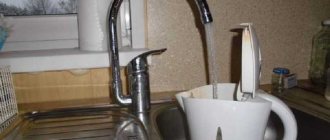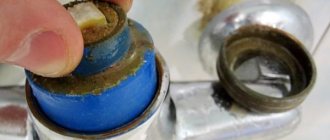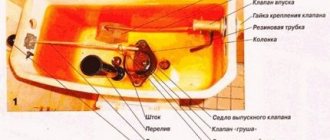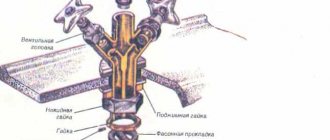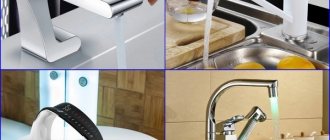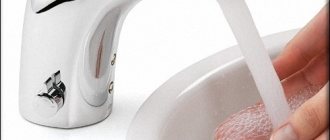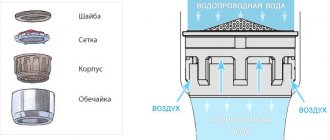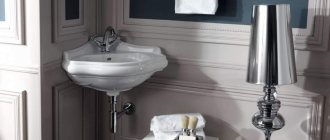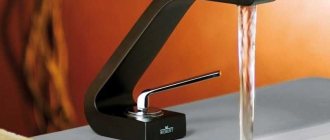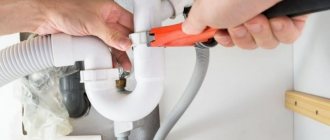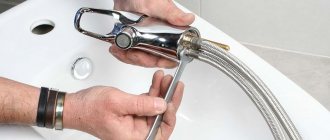Every homeowner must know the structure of a kitchen faucet so that they can promptly carry out the required repairs or replacement of this plumbing element. In order to disassemble a faucet in the kitchen, you first need to know the features and operating principle of each type of this device.
In the classic design, a distinction is made between single-lever and double-valve faucets.
The classic design of the mixer can be of the following two types, depending on the principle of operation:
- two-valve;
- single lever.
In addition to the above classification, all mixers can be divided into several types:
The principle of the tremostatic mixer.
- Standard. The devices only mix cold and hot water. This type of device is the simplest and most common.
- Filtering. Devices equipped with built-in membrane filters that are capable of trapping large particles. In addition, such devices can be equipped with carbon filters that purify water from organic impurities and chlorine.
- Thermostatic. Devices capable of adjusting water temperature.
- Multifunctional. Faucets that are equipped with filters and multiple spouts for separate washing of dishes and hands. Sometimes they have separate taps for connecting household kitchen appliances that consume water.
The most expensive are multifunctional devices.
Installation and repair of a kitchen faucet
Every homeowner must know the structure of a kitchen faucet so that they can promptly carry out the required repairs or replacement of this plumbing element. In order to disassemble a faucet in the kitchen, you first need to know the features and operating principle of each type of this device.
In the classic design, a distinction is made between single-lever and double-valve faucets.
The classic design of the mixer can be of the following two types, depending on the principle of operation:
In addition to the above classification, all mixers can be divided into several types:
The principle of the tremostatic mixer.
- Standard. The devices only mix cold and hot water. This type of device is the simplest and most common.
- Filtering. Devices equipped with built-in membrane filters that are capable of trapping large particles. In addition, such devices can be equipped with carbon filters that purify water from organic impurities and chlorine.
- Thermostatic. Devices capable of adjusting water temperature.
- Multifunctional. Faucets that are equipped with filters and multiple spouts for separate washing of dishes and hands. Sometimes they have separate taps for connecting household kitchen appliances that consume water.
The most expensive are multifunctional devices.
Differences between double-lever and single-lever faucets
The single-lever faucet design is considered the most convenient and practical. Models of mixing devices of this type compare favorably with others by the minimum time it takes for the jet to reach a given operating temperature and the convenience of adjusting the jet pressure and its temperature with one hand. Such devices have gained popularity among housewives, since very often only one hand is free during the cooking process.
The device with a two-valve design has now become less popular and is most often used in retro-style kitchens.
The device of a two-valve mixer.
Double-valve faucets, which have ceramic faucet axleboxes in their design, can easily compete in many respects with single-lever mechanisms, but they are definitely inferior to the latter in terms of practicality. The two-valve mixer is simpler in design. But this does not affect the cost of repairs, since the price of two crane axle boxes is almost equal to the cost of the cartridge used in the single-lever version.
One of the most important operational characteristics of the mixer is the coordinates of the location of the spout. The most practical devices are in the following cases:
- the outlet of the device spout is located relatively high, which allows you to place large containers or a large number of dishes for washing into the sink;
- the center of the flowing stream coincides with the center of the sink, which makes washing dishes more comfortable;
- The mixing device is equipped with a pull-out spout, which allows the mixer to be used outside the kitchen sink.
Many devices have spouts that allow you to create a thin and powerful pressure using an aerator and a soft, wide flow, convenient for washing vegetables and fruits.
Some multifunctional options that have a complex for water filtration are equipped with two spouts, filtered water is supplied through one of them, and regular water is supplied through the second.
Kitchen faucet nozzle
The most popular of them is the aerator
.
A kitchen faucet aerator is a metal (stainless steel or brass) or plastic cylinder that is attached with a threaded connection to the very end of the spout. Inside the aerator there is one, two or three mesh filters, through which the water is saturated with air and acquires a characteristic foamy color. Since the mesh covers 20-30% of the drain area, the water flow through the tap also drops by the same amount, while maintaining pressure.
The article on our website under the title will tell you about devices whose purpose is to make the work of housewives easier
About mixers that are controlled using
A mixer with a thermostat can be especially useful in the kitchen. A whole series of articles on our website is devoted to these gadgets. Go to one of them -
Our experts purchased several varieties of these “sprayers”, disassembled them and came to the conclusion that these are ordinary aerators, into which either an additional filter mesh was inserted in a homemade way, or, between the filters, a propeller-spinner or something else of the like. At best, they provide additional water savings of 5-6%, which does not correspond to their price.
A faucet with an aerator should not be confused with a kitchen faucet with a filter.
. With the advent of kitchen faucets with ceramic shut-off devices that are sensitive to contaminants in water, experts strongly recommend installing filters on the main pipes leading to the faucets to purify the water and reduce its hardness. But these are large industrial-type filters, which are in no case mounted in the faucet itself - simply on the pipe suitable for it.
The most advanced type of kitchen faucet attachment is LED
. This is a device with a temperature sensor and several lights that illuminate the stream of water coming out of the spout. Depending on the temperature, its color can change from red to blue. It is believed that such a device can protect against burns - do not put your hands under the scarlet stream from the tap!
Single lever kitchen faucet design
Single lever mixer device.
As a rule, a person’s reaction to a sudden failure of a faucet is to call a plumbing specialist and have him come to your home to carry out repair work. However, repairs can be carried out independently. For this purpose, you need to know how to disassemble the faucet in the kitchen.
In the design of a single-lever device, two main assembly parts can be distinguished:
- a mechanism that activates the water supply and ensures its mixing;
- a mechanism that provides spouting; it can be in a single housing with a mixing mechanism.
The design of a kitchen faucet includes the following details:
- an axial element for fixation with an external thread located on it;
- handle;
- decorative housing cover;
- a nut designed for fixation;
- cartridge;
- silicone or rubber gaskets;
- device body.
The cartridge, designed for mixing water flows, can be made of ceramic; in addition, models are available that have a more affordable ball version. A cartridge having this design consists of the following elements:
- a hollow ball equipped with a lever for connection with the handle;
- a removable element, the inner surface of which is made in the shape of a truncated sphere;
- an element for fixing, which has a cut thread on the surface;
- two spring-loaded bushings;
- plastic case.
The ball has three holes. Two of them, in the process of turning the lever, are combined with channels for water supply. The mixed liquid from the cavity of the ball is fed through the third mixing hole into the spout. An analogue made using ceramics is most often non-separable. The body of such a device has two plates with holes, and water is supplied by aligning these holes in the plates.
The removable spout is equipped with an internal threaded connection; an aerator is attached to its opposite end, which consists of a fine mesh and a nut for fixing it.
Causes of malfunction of a one-arm mixer
The design of single-lever kitchen faucets is divided into two types; the reasons for failure are almost always the same. Let's look at the types of faults:
- A ball valve valve is considered the most reliable option. But over time, it may become rusty. The Teflon seal also does not last forever and over time, water will begin to leak through the structural elements of the product - repairs will not take much time. Replacing the rubber bands with new ones is not difficult. The main problem may lie in the “ball” itself - if it is cracked, you will have to buy a new mixer;
- Unlike a ball valve, a ceramic cartridge is not afraid of corrosion and low-quality water. Such a product can last for many years, but there is one “But”. A grain of sand caught between the thin plates can chip the ceramic surface - you will have to replace the cartridge
- Often, blockages have a negative impact on the “rubber bands” of the mixer. If a leak appears, it is necessary to disassemble the device, clean it and replace rubber parts;
- Over time, the hoses may leak - this is only due to time (the pressing force weakens). You just need to tighten the connections;
- If microcracks appear on the body, no problem! They can be sealed with sealant. If the “rubber glue” does not hold up and water continues to drip, then you will have to buy a new faucet.
Most problems occur due to hard water. They can be avoided by installing a cleaning filter. In this case, the structure will last for many years without breakdowns.
We figured out how a kitchen faucet works, as well as the possible causes of malfunctions. It remains to consider such a question as eliminating possible malfunctions.
Single lever device repair
To carry out repair work you will need the following tools and materials:
Faucet repair tools.
- screwdriver;
- hex key for the mixer mounting screw;
- rubber or silicone gaskets to replace old ones that were previously installed in the mixer body.
Disassembling the mixer begins by disconnecting it from the cold and hot water supply lines by shutting off the valves located on the pipelines. After this, you need to open the mixer tap and release the remaining water from it. Then the fastening screw on the handle is unscrewed using a hexagon, and the handle itself is removed by lightly rocking from side to side.
After removing the handle, access to the threaded connection opens, which must be unscrewed. This connection, once disassembled, leads to the cartridge. There is a plastic part on top of the cartridge that can be removed with a screwdriver. Under this part there is a rubber seal ring, which must be checked for damage or absence and, if necessary, replaced. Very often it is necessary to clean the sealing ring from the deposits that form on it during operation of the mixer.
Failures
What fails most often in the products we are interested in?
Flexible hoses
Their service life rarely exceeds 5 - 7 years.
Over time, the rubber core loses its elasticity due to liming and begins to crack.
The problem is eliminated by replacing both hoses:
- The water is shut off.
- The union nuts of the hoses are unscrewed.
- The sink is removed.
- Old hoses are unscrewed from the housing and replaced with new ones.
Attention: do not screw in the hoses while holding them by the braid. This can only be done with a small adjustable wrench or narrow-nose pliers by touching the edges on the end. In addition, it is better to additionally wrap the pipe threads of the hose with FUM tape or a polymer sealing thread.
- The design plans in reverse order.
Cranbooks
Instructions for repairing faucets that have stopped turning off water depend on the type of faucet and the malfunction.
- On a screw valve that drips when closed, in most cases it is enough to replace the gasket. For replacement, plumbing stores sell special repair kits.
But: before you go to the store, open the tap several times until it stops and close it again. The cause of the malfunction may also be a piece of scale stuck in the body.
- A screw faucet that has turned and a ceramic one that has been crushed when trying to turn it when scale gets into the cutout of the plates can be repaired with your own hands only if you have a donor faucet with another breakdown. In most cases, it changes to an analogue.
Cartridge
Continuing to discuss the design and repair of sink faucets, a single-lever faucet much more often stops turning off the water due to a broken cartridge. Along with ceramic plates, when the lever is sharply jerked, their plastic clamps quite often break.
How to replace the cartridge?
- We turn off the water.
- Remove the decorative plug from the bottom or side of the lever.
- Unscrew the screw under it. It comes with a simple screwdriver or a hexagon.
- We remove the lever.
- Unscrew the decorative nut.
- Unscrew and replace the cartridge.
- We repeat the operations in reverse order.
Filter
A filter aerator on a gander is often caused by a drop in water pressure. It is enough to disassemble it and clean out all the dirt.
Division of kitchen faucets according to materials of manufacture
The material from which the kitchen sink faucet is made plays the most important role. Let's consider the options:
- Stainless steel. Steel products are reliable and durable and do not rust. They are easy to maintain and environmentally friendly, but require careful handling: in places of damage, some types of alloys may rust. Stainless steel faucets are less common, as they are more expensive than brass models (from 3 thousand rubles).
- Silumin (alloy of aluminum and silicon). Used for budget mixers (from 400 rubles). They are short-lived and have a simple appearance.
- Copper-based alloys (brass, bronze) or pure copper. Brass and bronze are resistant to water. Products made from them are strong and durable. They have a noble color and a long service life. They cost accordingly: from 1,000 to 100,000 rubles.
- Composite materials. A kitchen faucet made of this material is practical, durable, and comes in a variety of colors and shades. The price is above average (3000-20000 rubles).
- Plastic. Inexpensive high-tech material that can be adapted to any need. The mixer costs from 1000 rubles, is light in weight, but quite durable. Does not enter into chemical reactions with water. It has low thermal conductivity. But compared to metal faucets, it breaks faster.
Choose the outer material of the mixer according to your taste:
- The chrome surface (matte or shiny) is reliable and scratch-resistant, but you will have to wash this faucet more often: drops of water and fingerprints are especially noticeable on it;
- enameled models look very impressive, but the enamel is easy to damage;
- beauty, elegance and durability are combined with faucets with an external coating of marble, bronze or granite (the latter also have antibacterial properties);
- products imitated in gold and platinum are the dream of luxury and respectability embodied in an ordinary faucet;
- the most prestigious and expensive option is PVD - vacuum deposition. This type of coating guarantees a long service life even in the most extreme conditions. The strength of PVD is comparable to the strength of sapphire, so in everyday use the mixer is not afraid of any scratches or abrasions.
Classification of mixers by type of design
There are three main types of kitchen faucets.
Single lever
They are also called joystick, or single-team. They have become part of the daily life of almost every family.
There are two types of single-lever mechanisms:
- ball valve - the ball has several small holes; turning it regulates the flow of cold and hot water. The main disadvantage is the complexity of the design. The most common breakdown is considered to be abrasion of gaskets, cuffs and weakening of the spring support - all these problems cause faucet leakage;
- cartridge mechanism - consists of ceramic plates with holes. The lower disk is stationary, water flows through it, and the upper one is movable. The temperature of the water, as well as the intensity of its flow, depend on the total area of the holes.
Pros:
- efficiency;
- comfort during operation;
- practical design.
Minuses:
- high price;
- constant wear of the seal;
- complex design;
- expensive repairs.
Two-valve
A two-handle kitchen faucet with tap is a traditional option with two taps (for hot and cold water). It is chosen by people who prefer classic design or a retro . Such products are not as popular as single-lever faucets due to less convenience.
Double-valve faucets are more expensive. But their advantage is savings due to more precise adjustment of the water supply), they are easy to repair yourself, and they fit better into classic interiors.
Pros:
- simplicity of design;
- high maintainability;
- low cost.
Minuses:
- there is no uniform standard in the manufacture of crane axle boxes;
- high fluid consumption: time is required to adjust the temperature;
- minimum operating comfort.
Automatic kitchen sink faucet
It involves contactless use: just put your hands or a pan under the tap, and the water will flow by itself. In general, electronic products still occupy a relatively modest niche in the market. This is explained by the high price of goods and the limited range of models.
Pros:
- low water consumption;
- hygiene (no hand contact with the tap);
- durability.
Minuses:
- high price;
- the need to bring your hand to the thermostat several times to draw water into a large container.
Additional functionality and features
In addition to their design differences, kitchen faucets are distinguished by their aesthetic value and small but remarkable details that make the faucet ideal for your kitchen:
- high spout - convenient if there is a need to collect water in a tall and large container, for example, a bucket or jug;
- possibility of rotation - the greater the rotation angle, the more convenient the kitchen faucet;
- direction of the stream to the center of the sink - the stream of water from the tap should hit the center of the sink at an angle of at least 90 degrees. When you turn on a stronger pressure, if you have chosen the spout correctly, the stream falls a little closer to the edge of the sink. This is the most convenient option for washing dishes. If the spout is too close to the edge of the countertop, water will splash onto the floor;
- retractable hose - these faucets are especially convenient if you need to fill a large pot or bucket with water. Thanks to the hose, this can be done outside the sink. The hose is made of high quality rubber and protected by a textile or metal braid.
Let's sum it up
When looking for a suitable mixer model from a photo, you should consider the following facts:
- a single-lever device is more convenient to use than a double-lever device;
- a high-mounted spout makes it possible to place large items in the sink;
- the washing process will be convenient if the center of the stream is aligned with the center of the sink;
- a pull-out spout allows you to supply water from the faucet outside the sink;
- The shower function makes it easy and efficient to rinse anything or wash fruit.
The designs of single-lever and double-lever faucets are quite simple. The complex elements in the first are cartridges (ball or ceramic), in the second - valve axle boxes (valve or ceramic).
Criteria for choosing a kitchen faucet
First of all, pay attention to the place where it will be installed and the type of sink. A double sink will require a swivel spout. In addition, if you install a kitchen faucet near a window that needs to be opened, it is worth considering options with an adjustable spout height. Such models are also suitable for washing tall dishes.
Another important factor is the shape of the spout (or “spout”). The most popular are straight options, and they look more aesthetically pleasing, but a kitchen faucet with an arc-shaped spout is more functional and convenient to use, especially in cases where you need to pour water into a high container.
To choose a kitchen faucet, find out which design will be more convenient for you: single-lever or double-valve. The answer to this question comes purely from your personal preference. Many experts advise buying a kitchen faucet with one handle: if you cook a lot, such a faucet will save time. On the other hand, a single-lever faucet is less economical and mixes water longer than a double-valve faucet.
Design features of the spout
Particular attention should be paid to the spout of the kitchen faucet. The design of the structure, functionality and ease of use largely depend on it. Based on the type of body, kitchen faucets are divided into solid, rotary, and prefabricated.
The first option is a cast housing with a control lever. Solid-cast faucets are highly durable, and the minimum number of connections significantly reduces the likelihood of leaks. In prefabricated models, in addition to the control lever, there is another moving part - the spout. Such faucets are more functional and comfortable to use than solid structures.
When choosing a faucet, you should also consider the height of the spout. The size of the “gander” largely depends on the depth, shape and number of bowls in the sink. It should not interfere with washing tall dishes and collecting liquid, but at the same time, water falling from the high spout will splash around.
When deciding how to choose the size of a faucet for a kitchen sink, you need to take into account that they are divided into:
- low (up to 190 mm);
- medium (up to 240 mm);
- high (more than 240 mm.).
Faucets are equipped with spouts of various shapes:
- L-shaped;
- R-shaped;
- S-shaped;
- J-shaped;
- C-shaped.
Spouts also differ in cross-sectional shape: round, rectangular and square. This variety allows you to choose the necessary model for a specific interior design and furniture. Manufacturers of plumbing and kitchen equipment offer models with flexible and articulated spouts that can change their geometry and length.
Mixer installation type
When dealing with the question of how to choose the right faucet for your kitchen, you must immediately decide on the location of its installation. This is quite an important point to consider when purchasing a kitchen faucet.
Most of the faucets on the modern plumbing market are designed for installation directly on the kitchen sink. Manufacturers adhere to a single standard for seating and mounting of cranes. Faucets on a kitchen sink are usually fixed using a tightening nut, and less often, using studs.
Having decided to install a water tap on the countertop near the kitchen sink, you need to choose a special model designed specifically for this type of installation. Since the material of the working surface is 32 mm, the threaded part of the tap may not be enough and therefore you will have to purchase studs with a sufficient length.
Mounting a kitchen faucet on the wall is becoming less and less common. This installation method may be caused by interior design features or by the fact that sometimes the water pipes are connected to the sink in exactly this way and changing their location is impossible or impractical. The main advantage of this installation is that it frees up space near the kitchen sink.
Kitchen faucet design: design, principle of operation
Kitchen faucets come in a huge variety. They have distinctive design features and appearance. Today, faucets have become not only a device that allows you to comfortably use the water supplied through the plumbing, but also a decoration that complements the design of the sink and looks great against the background of the overall interior of the kitchen space. You can read more about the structure of mixers, their types, design differences, advantages and disadvantages right now.
There are not many main types of kitchen faucets. Below are the main models most commonly found in the kitchen.
Double valve kitchen faucet
Despite the fact that single-lever kitchen devices have begun to find active use in everyday life, valve-type mixers remain the most common today. With such faucets, one valve is used to control the supply of hot water, the other - cold. The valves can be positioned horizontally and at a certain angle to each other.
Types of two-valve mixers
Two-valve mixers are available in two types. They differ from each other by various locking elements. These can be crane axle boxes with elastic gaskets or ceramic plates.
In mixers of the first type, a reciprocating faucet closes or, on the contrary, opens the hole through which water flows from the pipe. In other types of faucets, water supply or blocking is possible by aligning the holes of a pair of ceramic plates.
The advantages of faucets with the first type of locking mechanism include:
- Lower cost;
- Ease of operation;
- Ease of obtaining water at the desired temperature by adjusting the valves;
- Versatility - over time, the elastic crane axle box can be replaced with a ceramic one, provided that they were produced by the same manufacturer.
The disadvantages of valve-type mixers with an elastic gasket are the need to make several turns of the valve until the water supply holes are completely open, and rapid wear of the rubber gasket.
Faucets with ceramic valves have the following positive qualities:
- Increased wear resistance and, as a result, a longer service life;
- Easy to adjust water temperature due to the fact that the angle of rotation of the valves is 90 and 180 degrees;
- Easy to control the mixer.
Design of a two-valve kitchen faucet with ceramic gaskets
Structurally, a mixer with two valves consists of a body, a faucet-axle made of ceramic or metal, valves, a spout with an aerator. The ceramic axle box consists of:
The body is made from alloys of certain types of non-ferrous metals. It has a rubber gasket in its design. It is needed so that the faucet axle box fits closely to the mixer body and water does not leak out. The lower part of the faucet housing has holes through which water enters the chamber and mixes there. To unscrew the faucet box made of ceramics, you need to use an adjustable wrench, gas wrench or wrench.
The retainer is a small part that is needed to tightly connect the valve axle housing and the rod. It snaps into place when the rod is inserted into the body. To separate them, just use a regular screwdriver.
The mixer valves are connected to the stem and then secured with special screws. There is a groove on the rod body that serves to snap the lock into it, and at the bottom there is a recess for the turn signal.
- turn signal
It is necessary to transmit torque from the mixer valve to the ceramic plate, against which it actually rests. The turn signal can be either plastic or metal; it is better if it is made of metal, since the plastic one quickly breaks if the valves are tightened too tightly;
- Top and bottom plate
Kitchen faucet repair
What to do if the kitchen faucet is leaking?
Disassemble the kitchen faucet and troubleshoot problems. If this is a crane with worm axle boxes, then, most often, you can get by by replacing the rubber gaskets. In more modern models, you will have to change the ceramic cartridge.
How to change a kitchen faucet if, for example, a crack is discovered in the body? - Remove and install a new one!
A single-lever, or as it is also called, an articulated mixer, is positioned as an extremely reliable and convenient device in everyday life, indispensable in modern everyday life. But, like any other design, it has its flaws and can fail. If you know how a single-lever kitchen faucet works, there is no need to call a plumber - you can do all the troubleshooting work yourself.
The design of the one-arm kitchen faucet is extremely simple and effective. With one hand you can adjust the water pressure and its temperature. In the technical documentation you may come across such names as mono-command, articulated (for the bathroom) and joysticks. Please be aware that we are talking about single-lever faucets.
Let's consider the main quality characteristics of the product:
- Durability. This factor is due to the absence of rubbing metal elements. All parts subject to wear are made of ceramics, which withstand the effects of abrasive particles. That is why such faucets are not afraid of process water (filters are installed directly in the faucet and make the water drinkable);
- Elegant design. Another important point that attracts consumers. Modern single-lever kitchen faucets are attractive designs that will fit seamlessly into any kitchen. They can be chrome, nickel or colored plated.
The above factors are complemented by ease of operation and low cost of products. But, as mentioned above, poor quality water, interruptions in the water supply system and slight mechanical damage can lead to unwanted breakdown of the device. To fix a broken faucet yourself, you need to study the design of the device, which is what we will do now.
The single-lever kitchen mixer consists of the following structural elements:
- Control lever;
- The regulator rod is fixed with a nut;
- Hidden in the body of the product is a ceramic cartridge or ball valve with three holes. The stable position of the element is ensured by rubber seats;
- The single-lever mixer is equipped with cuffs (adjusting and steam) and a special ring.
There can be many reasons why a malfunction occurred. But if the cartridge (ball valve) is intact, then repairing the kitchen faucet will be quick.
The design of a one-arm kitchen faucet is clear to us. It remains to figure out the possible causes of the breakdown and how to eliminate them.
Lever kitchen mixer
Lever mixers are actively gaining popularity. They look stylish, are easy to use, and come in a variety of designs. A sink with such a mixer attracts attention primarily because the faucet is strikingly different in appearance from its already familiar two-valve counterpart.
Lever kitchen mixer design
Structurally, a lever-type mixer consists of the following elements:
- Handles that control the water supply (its pressure and temperature);
- Jet regulator (a special nozzle that is screwed onto the end of the spout using a threaded connection, otherwise this nozzle is called an aerator);
- Decorative casing of the mixer cartridge;
- A cartridge that is fixed through a nut. The cartridge mixes the water coming through the pipes and then pours it into the drain hole. He himself is hidden in the case;
- Fixing bracket.
The design of a kitchen faucet may differ slightly, but the principle of supplying water to the spout is approximately the same.
Varieties in design
Lever type mixers may differ in the design of the mixing unit. Its device can be ball or cartridge. In the first case, inside the ball sleeve there is a hollow metal ball that has three holes - two small ones through which hot and cold water enters it, and one large one for discharging water into the spout. Mixing of water occurs precisely in the spherical cavity.
Advantages of mixers with this design:
- Durability;
- Ease of operation;
- Ease of obtaining water at the desired temperature.
One of the few disadvantages is the need to periodically replace the o-rings, which wear out two or three times in 2 years.
Lever mixers with a ceramic cartridge differ in the principle of supplying and shutting off water coming from the pipes, but this difference is only constructive. The cartridge body contains ceramic plates that are made of aluminum oxide. There are two of them. The bottom plate has three holes through which water passes - two small and one larger. In order for water to enter the drain, it is necessary that the top plate occupies a position in which one or the other hole is open separately or at the same time halfway. Accordingly, cold or hot water or warm, mixed water will flow into the spout. Mixing of water occurs inside the chamber.
The advantages of faucets with a ceramic cartridge include a long service life, ease of mixing water to a certain temperature, and the use of one hand to operate the tap. And the disadvantages are that in some models of mixers that are not of very good quality, it is difficult to get water at a comfortable temperature (you have to search for a long time for the position of the lever).
Types of kitchen taps
Taps, like mixers, are divided into two large groups - valve and lever. Within each group there are two subgroups.
Valve tap in the kitchen
Valve
are divided into valves with a worm axle and with a ceramic one.
Lever
– for kitchen ball faucets and kitchen faucets with ceramic inserts.
More information about the design of a kitchen faucet of any of these types can be found in the materials about the corresponding types of mixers. It should be taken into account that the kitchen ball faucet is no longer produced by the industry, but due to inertia, all types of lever faucets are often called this way.
The design of a kitchen faucet is identical to that of a bathtub or sink faucet, but there are several specific designs that are used only for kitchen sinks. One of these is a kitchen faucet with a pull-out shower.
The nuance of such a device is that inside its spout (the “pipe” of the faucet) there is a miniature shower on a flexible hose 70-80 cm long. It can be pulled out of the “pipe” and, say, washed from different sides of a large dish or a cast-iron duck pot , which is inconvenient to move in the sink.
The shower is pulled back into place under the weight of a weight, which is connected by a wire to the shower head, and the wire itself passes through the “pipe” of the spout. However, there are designs of a kitchen faucet with a shower, which is held on a screw spring wrapped around the spout; there are other design options.
Another specific kitchen design is the dual spout kitchen faucet. Two tubes are hidden in the body of such a faucet: one for supplying technical water for washing dishes and the other for drinking water. The flow is switched using the same lever handle as in a regular “ball” kitchen faucet.
Both pipes of the two-spout kitchen faucet are hidden in a hollow console hanging over the sink sink; Only their tips protrude outward. Visually, a kitchen faucet with two spouts is difficult to distinguish from a regular one with a massive “pipe”.
The standard material used for kitchen taps is chrome-plated brass. Sometimes there are advertisements for kitchen taps made from more prestigious materials - even gold and platinum.
As a rule, these are the same brass taps, “painted” with special coatings like gold, platinum, etc.
Touchless faucet
Touchless faucets are an undoubted know-how. Thanks to the constant development of technology and affordability, they are increasingly being installed in private homes and apartments. Their main advantage over their mechanical counterparts is that there is no need to turn the valves to allow water to flow into the drain and obtain its comfortable temperature. All you have to do is place your hands near the drain hole and enjoy the flowing water.
The main advantages of a contactless (touch) faucet:
- Saving water. In order to wash your hands or draw water into the kettle, you do not need to unscrew the valve and then spend some time screwing it in, into which water will continue to flow;
- Ease of use - no work required to open and close the tap;
- Constant temperature of the water poured out. Despite periodic changes in water temperature during central heating, the sensor mixer will maintain it at the same level;
- Hygiene. When using a classic faucet, many people touch the valves, which reduces the hygiene of the procedures. In a touch mixer, you don’t need to touch anything except the regulator;
- It is easy to customize the operation of the mixer using the buttons on the body or the control panel. With a few keystrokes, you can program the water temperature, the speed of its flow and the flow time after the person’s hands are removed from the sensors’ coverage area.
